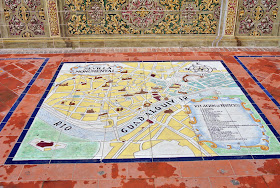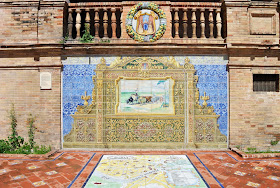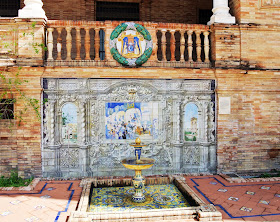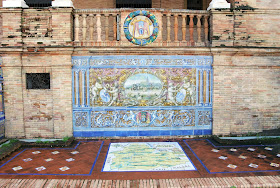 |
| I visited Sevilla on the eve of Semana Santa, the subject of this tile display at the Plaza de España |
I first got interested in tile art because Valencia has a tradition of it. But, in truth, many places in Europe have this tradition. Sevilla, however, is interesting and distinctive because it has really embraced it. Tiles are everywhere! As you wander through the city and its famous tourist sights, it seems like every feature of life and culture there has, at some point, in some way, been refracted through a depiction that was burnt or painted onto a tile. Much like my obsession with pomegranate iconography in Granada, I pretty quickly caught a bad case of azulejomanía.
Here, in honor of Sevilla's "Feria de Abril" which commences tonight, I share with you some images of the city, as seen through its tiles...
• Real Alcázar:
The presence and importance of the Real Alcázar, a magnificent fort built during the Moorish occupation of the city (712-1248), is clearly what inspires the long, sustained local tradition and interest in tile art. So it's a good starting point for our tile tour.
 |
| Much like the Alhambra in Granada or the Mezquita in Córdoba, a defining feature of the Real Alcázar was its distinctive Moorish, in this case Mudéjar style. |
 |
| These green tiles were clearly the signature pattern for the Alcázar. |
 |
| Okay, it's not tiles, but the ceiling of the Hall of Ambassadors is beautiful! |
 |
| I particularly liked this blue tiled staircase! |
 |
| The gardens were pretty magnificent... |
 |
| ... and had more tiles! |
 |
| "Plus Ultra", Latin for "further beyond", motto of Rey Carlos V and of Spain today. |
Digression, a fun game: One of the photos above isn't actually from Sevilla, but was instead taken during my recent visit to Istanbul. Can you guess which one? It was really interesting to compare the fusion of East meets West in Sevilla (and Córdoba) with that of Istanbul
• Virgin Tile Iconography:
So did you know that Spain is a Catholic country? No? Well, let me tell you… Okay, I'm clearly being facetious here, but it was pretty 
• La Cartuja & Plaza de España:
Two other important stops on our tile tour are La Cartuja, which was at one point in time actually a ceramics factory, though today acts as a contemporary art exhibit space, and the renowned Plaza de España, a faux, decorative square built in 1928 for the Ibero-American Exposition of 1929.
 |
| The only tiles you'll see at La Cartuja are in this unused entryway, a beautiful vestige of the factory's earlier days. |
 |
| These oven towers were mammoth and impressive, and a nice industrial backdrop for a contemporary art museum. |
 |
| Panoramic of the Plaza de España, which is much larger than I had remembered it from my previous visit |
 |
| Nice bridges with ceramic adornments! |
 |
| Scattered throughout the regional displays were special displays on the cultural highlights of Sevilla. |
 |
| Even tile maps of (1928) Sevilla's landmarks and neighborhoods. |
 |
| But the true touristy brilliance of Plaza de España are the opportunities it provides visitors to snap a photo with the display for their home city... like the one for my beloved Valencia!!! |
• Casa de Pilatos:
This beautiful 15th-16th century palace is like a temple to the tile gods. By this point in the journey I was completely taken by azulejomanía, and took hundreds of photos of the tiles. I'll spare you that longer photo journey and only post a select six here. Let's just say it's worth a visit!
 |
| Tile heaven! |
• "Azahar" and the "other" orange city:
When I was considering possible quirky touristy photo games for Sevilla, one idea was to look for references to "azahar" that are all over the city. Azahar is the Spanish name for orange blossoms, and I quickly realized that Sevilla is as much an orange city as Valencia. There were orange trees everywhere, and the azahar was just starting to bloom. In the end I decided it didn't quite have the same catch as Granada's pomegranate iconography, but it was interesting how Sevilla really seemed to sell the azahar, whereas Valencia sells the orange fruit imagery.
 |
| Budding orange blossoms. |
• Tiled oddities, to categorize under "Miscellaneous":
And then there were all the other tile discoveries I found, some odd, some interesting, all dutifully documented by this clearly obsessive compulsive photographer.
 |
| This joint had some cool tile decoration, but I was really drooling over its incredible collection of coffee pots! |
 |
| This tile display clearly belonged to a church whose patron saint was Grouch Marx... |
 |
| Being the food market junky, I couldn't pass on a visit to the Mercado de Triana. |
 |
| Nice tiled dome at the Castillo de San Jorge! |
 |
| I stumbled upon this bizarre, awesome tile ad throwback, which, thanks to Delikat Essences, I now know has an interesting back history. |
 |
| "Aquí vive gente de Triana", I can just hear this said with a proud Sevillano accent by some Flamenco dancer! |
 |
| I especially liked the wild tiles at El Rinconcillo, the oldest restaurant in Sevilla. |
• Street art, pre-Semana Santa "pasos", and, okay, other art not really at all about tiles:
Okay, so I wasn't only looking at tiles. There were plenty of other interesting eye candy and artistic mediums of expression throughout Sevilla. Here are some other things that caught my eye...
 |
| Speaking of eye candy, how adorable are these Semana Santa candy figurines!?! |
 |
| This very cool shadow-like mural is apparently for a bar, Bar Antojo. Thanks loubylou79 for letting me know! |
 |
| I don't know if this was street art or an ad, but I loved it! What a great play on the Giralda and Bull! |
 |
| One of the coolest street art discoveries was learning that the Sevilla trash company sponsors a contest for decorating the recycling containers. The "TODOTUYO" project by cleaning company LIPASAM... Brilliant! Again, thank you Delikat Essences for tipping me off about it. |
As I said, I arrived to Sevilla on Semana Santa Eve, and much like how the weeks leading up to Fallas one can get a sneak preview of the falla displays, this meant that I could catch a preview of the amazing religious alters that would be paraded around during the religious Easter festivities the following week.
 |
| Mounting and polishing these altars was no small achievement. |
So I'll add my voice to the chorus of calls hailing Sevilla as a beautiful destination to visit. We had an amazing time there and I definitely recommend it, not only for the tiles!
 |
| ¡Feliz Feria de Abril! |






































The tiles were something I fell in love with during my first year in Seville, and ceramics are a common gift from me to visitors (sorry about all that extra weight!). I surprised you didn't mention Triana, where there's an abundance of the tiles because of its proximity to La Cartuja and the tradition there. I have fond memories of tile virgins, old mans bars lined with azulejo and checking out stores daily for new merch!
ReplyDeleteHi Cat! Sorry we weren't able to meet up while I was there. Hopefully next time!
ReplyDeleteI totally relate to you on tile-gifting. I also burden my visitors with tile-laden luggage because of Valencia's (less conspicuous) azulejos tradition. It was fun to study them in Sevilla. Triana doesn't feature more heavily here because I barely had time to scratch the surface of that neighborhood, though there is the one photo there towards the bottom. There is clearly too much to see in your town!
Great post and great pictures. I really enjoyed your view of the city. Thanks for the mention :-)It was a pleasure to guide you through Seville & Córdoba.
ReplyDeleteDelikat Essences, of course I would have to mention you here, since our tour of Sevilla and Córdoba was thoroughly enriched by your suggestions and your passion for both cities. I hope all my readers visit your blog before they visit them, too.
ReplyDeleteIt was great to meet you, and we hope we can persuade you to let us return the favor sometime with your visiting Valencia ;)
My now husband of 31 years and I chose Spain for our first trip together in 1981. (Don't do the math). I can't remember if knew it would be la Semana Santa when we bought our plane tickets, but we arrived in Sevilla, with no hotel reservation (remember, no easy internet booking), just in time for la Semana Santa. We found a room in Dona Pepa's place in the Jewish Quarter. Dona Pepa was someone out of some novel (you tell me which one)--dressed all in black, sitting in a darkened room with heavy drapes and crammed with heavy furniture. Our room can best be described as slimy (including between the sheets). It is still the benchmark against which we measure all hotel accommodations. So far, we've come close, but have not managed to surpass the awfulness. (I apologize for this tangential comment. All it took was "Sevilla" and "semana santa" ;-)
ReplyDeleteSuch a great idea for a cool post. You just made me want to go to Sevilla again! Amazing amount of tile work going on there!
ReplyDeleteSevilla could be a great spot to require in associate degree exhibit, whether or not you wish to visualize painting, sculpture, design, or photography. there is continually one thing to visualize because of the Ayuntamiento and Cajas that sponsor such events. non-public studios are often found throughout the middle with rotating collections by native artists.
ReplyDeletevisite nuestro sitio: http://www.sunstylesuitesorlando.com/
On parasta osallistua kilpailuun luultavasti suurimmista blogeista verkossa. Suosittelen tätä verkkosivustoa!
ReplyDelete
ReplyDeleteI appreciate the time and effort to write this kind of article. Thanks
ReplyDeleteIm glad to have found this post as its such an interesting one!
ReplyDeleteExcellent read, I just passed this onto a friend who was doing a little research on that.
ReplyDeleteAnd he actually bought me lunch as I found it for him smile Therefore let me rephrase that:
ReplyDeleteI am thankful to you that you produced this!
ReplyDeleteNicee post!!Thanks for sharing this quality information with us.